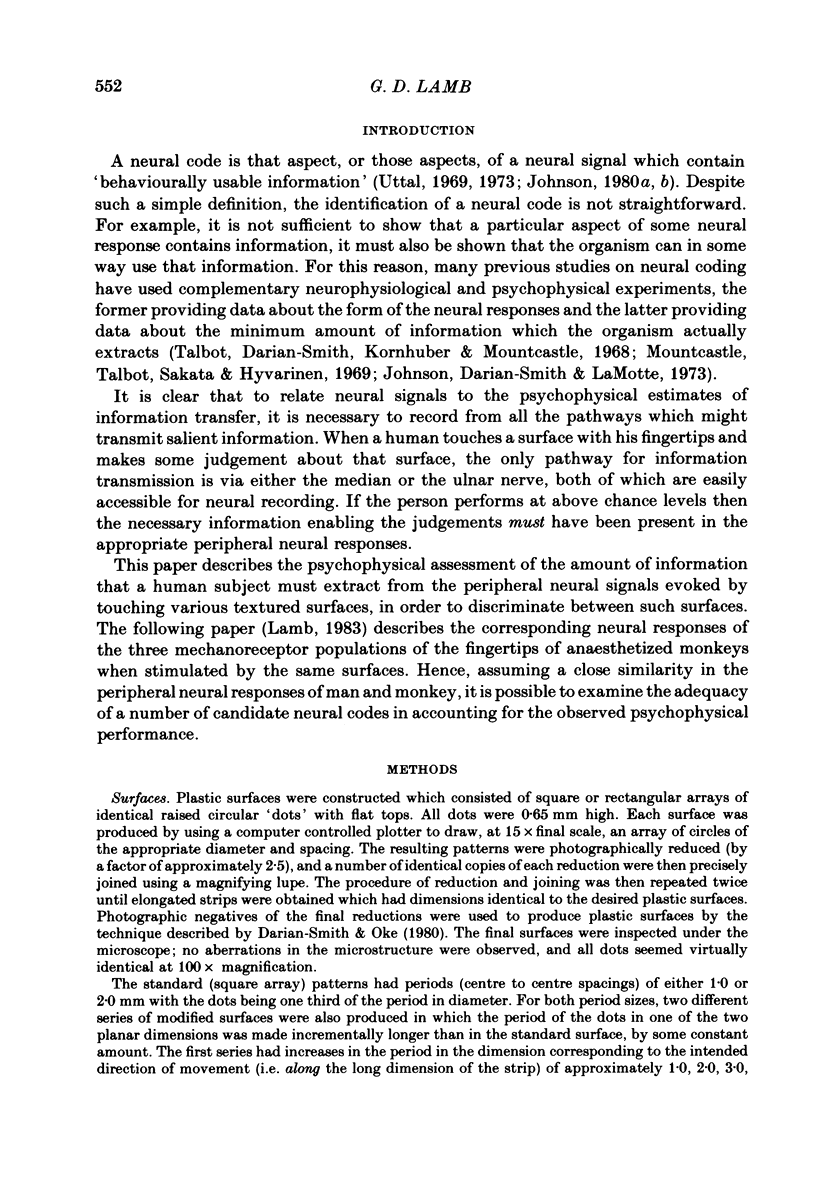Abstract
Psychophysical experiments were designed to assess the tactile discriminative abilities of human subjects when touching textured surfaces. Plastic strips were produced which had raised dots in a square arrangement (standard surface) or in one of a number of rectangular arrangements (modified surfaces) in which the spacing of the dots differed from the standard surface by some constant amount in one direction. Subjects were presented with pairs of surfaces and asked to discriminate whether each pair consisted of (a), two identical standard surfaces, or (b), a standard surface and a modified surface. Performance measurements were analysed using decision theory. When subjects moved their fingers over the surfaces (active touch) their responses were virtually unbiased, and there was a linear relationship between discriminative performance and the difference between the spacing of the dots on the two surfaces. At the 75% correct level, subjects could distinguish surfaces in which the period of the dots differed by only 2%. Performance was virtually independent of the method of movement used, despite large differences in the velocity profiles of the various movements. Experiments in which the surfaces were moved under the subject's stationary finger (passive touch) displayed the same linear relationship between performance and period difference as in the active-touch experiments. Furthermore, the discriminative performance levels were very similar in the two types of experiments. In the passive-touch experiments, subjects could distinguish smaller differences in period in the surface dimension parallel to (along) the direction of movement than they could distinguish in the dimension perpendicular to (across) the direction of movement. The hypothesis is advanced that normal active discrimination of surfaces is made possible by using similar movements in successive surface contacts and a relatively simple neural code.
Full text
PDF














Selected References
These references are in PubMed. This may not be the complete list of references from this article.
- Darian-Smith I., Oke L. E. Peripheral neural representation of the spatial frequency of a grating moving across the monkey's finger pad. J Physiol. 1980 Dec;309:117–133. doi: 10.1113/jphysiol.1980.sp013498. [DOI] [PMC free article] [PubMed] [Google Scholar]
- Johnson K. O., Darian-Smith I., LaMotte C. Peripheral neural determinants of temperature discrimination in man: a correlative study of responses to cooling skin. J Neurophysiol. 1973 Mar;36(2):347–370. doi: 10.1152/jn.1973.36.2.347. [DOI] [PubMed] [Google Scholar]
- Johnson K. O., Lamb G. D. Neural mechanisms of spatial tactile discrimination: neural patterns evoked by braille-like dot patterns in the monkey. J Physiol. 1981 Jan;310:117–144. doi: 10.1113/jphysiol.1981.sp013540. [DOI] [PMC free article] [PubMed] [Google Scholar]
- Johnson K. O., Phillips J. R. Tactile spatial resolution. I. Two-point discrimination, gap detection, grating resolution, and letter recognition. J Neurophysiol. 1981 Dec;46(6):1177–1192. doi: 10.1152/jn.1981.46.6.1177. [DOI] [PubMed] [Google Scholar]
- Johnson K. O. Sensory discrimination: decision process. J Neurophysiol. 1980 Jun;43(6):1771–1792. doi: 10.1152/jn.1980.43.6.1771. [DOI] [PubMed] [Google Scholar]
- Johnson K. O. Sensory discrimination: neural processes preceding discrimination decision. J Neurophysiol. 1980 Jun;43(6):1793–1815. doi: 10.1152/jn.1980.43.6.1793. [DOI] [PubMed] [Google Scholar]
- Lamb G. D. Tactile discrimination of textured surfaces: peripheral neural coding in the monkey. J Physiol. 1983 May;338:567–587. doi: 10.1113/jphysiol.1983.sp014690. [DOI] [PMC free article] [PubMed] [Google Scholar]
- Mountcastle V. B., Talbot W. H., Sakata H., Hyvärinen J. Cortical neuronal mechanisms in flutter-vibration studied in unanesthetized monkeys. Neuronal periodicity and frequency discrimination. J Neurophysiol. 1969 May;32(3):452–484. doi: 10.1152/jn.1969.32.3.452. [DOI] [PubMed] [Google Scholar]
- Talbot W. H., Darian-Smith I., Kornhuber H. H., Mountcastle V. B. The sense of flutter-vibration: comparison of the human capacity with response patterns of mechanoreceptive afferents from the monkey hand. J Neurophysiol. 1968 Mar;31(2):301–334. doi: 10.1152/jn.1968.31.2.301. [DOI] [PubMed] [Google Scholar]
- Uttal W. R. Emerging principles of sensory coding. Perspect Biol Med. 1969 Spring;12(3):344–368. doi: 10.1353/pbm.1969.0027. [DOI] [PubMed] [Google Scholar]


